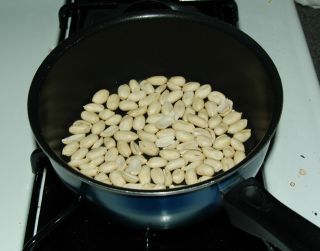 I can't eat too much peanut brittle at one time, so I decided to halve the recipe that Alton presents on his show. Alton started with lightly salted, roasted peanuts. I had blanched peanuts in my pantry, so I started by lightly toasting them in a small pan. Raw, blanched, or roasted are all good in brittle. If you've got raw or blanched, you can optionally follow this step to bring out a little bit of the toasted flavors. If you've got roasted peanuts, then skip ahead to ingredient assembly. Over medium heat, I kept the peanuts (3/4 cup) constantly moving and tossing them every ten seconds or so. This keeps the peanuts from burning while the heat is developing and concentrating the peanut flavors and smells. As the peanuts start to change color, I threw in a pinch of table salt (kosher grains are a bit large for peanuts). My constant tossing incorporated the salt evenly and when the peanuts became a light yellow with dark brown spots, I removed them from the heat into a medium bowl.
I can't eat too much peanut brittle at one time, so I decided to halve the recipe that Alton presents on his show. Alton started with lightly salted, roasted peanuts. I had blanched peanuts in my pantry, so I started by lightly toasting them in a small pan. Raw, blanched, or roasted are all good in brittle. If you've got raw or blanched, you can optionally follow this step to bring out a little bit of the toasted flavors. If you've got roasted peanuts, then skip ahead to ingredient assembly. Over medium heat, I kept the peanuts (3/4 cup) constantly moving and tossing them every ten seconds or so. This keeps the peanuts from burning while the heat is developing and concentrating the peanut flavors and smells. As the peanuts start to change color, I threw in a pinch of table salt (kosher grains are a bit large for peanuts). My constant tossing incorporated the salt evenly and when the peanuts became a light yellow with dark brown spots, I removed them from the heat into a medium bowl.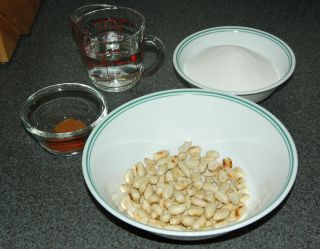 Along with the 3/4 cup peanuts, I assembled 1/4 tsp. cinnamon, 1/4 tsp. cayenne pepper, 1-1/2 cup granulated sugar, and 3/4 cup water. That's all - it's the shortest ingredient list for any peanut brittle recipe that I'm familiar with.
Along with the 3/4 cup peanuts, I assembled 1/4 tsp. cinnamon, 1/4 tsp. cayenne pepper, 1-1/2 cup granulated sugar, and 3/4 cup water. That's all - it's the shortest ingredient list for any peanut brittle recipe that I'm familiar with. 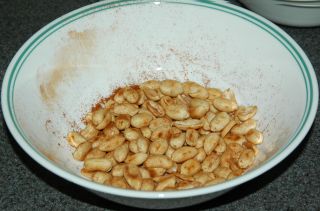 I mixed the peanuts with cinnamon and cayenne pepper by tossing a couple times in the medium bowl. I was glad to see Alton Brown adding cayenne pepper to his peanut brittle. A bit of spiciness in sweets helps to heighten the flavors and punch of the other spices (like the cinnamon in this case). This is a "trick" well known to chocolatiers and made famous by the movie Chocolat.
I mixed the peanuts with cinnamon and cayenne pepper by tossing a couple times in the medium bowl. I was glad to see Alton Brown adding cayenne pepper to his peanut brittle. A bit of spiciness in sweets helps to heighten the flavors and punch of the other spices (like the cinnamon in this case). This is a "trick" well known to chocolatiers and made famous by the movie Chocolat.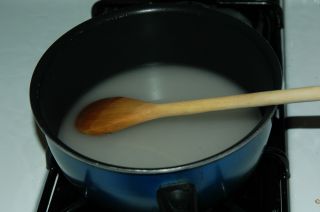 Over on the stove, I combined the water and sugar in a saucepan. I used a nonstick saucepan, but if you're using a traditional pan, then you'll want to rub the interior surface of the pan down with vegetable oil. Over medium-high heat, I dissolved the sugar into the water and brought it to a boil. At this point, I deviated slightly from Mr. Brown and added about a tablespoon of corn syrup to prevent unwanted crystalization.
Over on the stove, I combined the water and sugar in a saucepan. I used a nonstick saucepan, but if you're using a traditional pan, then you'll want to rub the interior surface of the pan down with vegetable oil. Over medium-high heat, I dissolved the sugar into the water and brought it to a boil. At this point, I deviated slightly from Mr. Brown and added about a tablespoon of corn syrup to prevent unwanted crystalization.While the syrup was coming to a boil, I prepared a half sheet pan by dropping a Silpat baking sheet onto the pan. Silpat is probably the most popular brand for non-stick baking mats made by coating weaved fiberglass with a layer of food safe silicone. The sheets are reusable, easy to clean, durable, temperature resistant, and really, really non-stick. I find them invaluable for not just making pastries (the main use for silicone baking mats), but also for working dough, making oven baked steak fries, and of course, working with melted sugar. If you don't have a silicone baking sheet, just use parchment paper - but, I'd grease it with a lot of butter to ensure nothing will stikc (sugar is really sticky).
 Once the syrup starts to boil vigorously, I tried out Alton's tip to cover the pot for three minutes to allow steam to collect and water to stream down the sides of the pan (to clean off any sugar on the sides of the pan). After the three minutes, I noticed that water had streamed back down, but not evenly. The pan was indeed cleaner, but not so much that I thought the step was useful, especially in light of what happens over the next ten minutes. As the water boiled off and the sugars started to heat up, additional sugar droplets were splattered onto the sides of the pan by the little bursting bubbles. Oh, well. When the sugar turns a light amber color (if you're using a candy thermometer, look for 350°F; like Alton, I eyeball most of my candies), we're ready to introduce the peanuts.
Once the syrup starts to boil vigorously, I tried out Alton's tip to cover the pot for three minutes to allow steam to collect and water to stream down the sides of the pan (to clean off any sugar on the sides of the pan). After the three minutes, I noticed that water had streamed back down, but not evenly. The pan was indeed cleaner, but not so much that I thought the step was useful, especially in light of what happens over the next ten minutes. As the water boiled off and the sugars started to heat up, additional sugar droplets were splattered onto the sides of the pan by the little bursting bubbles. Oh, well. When the sugar turns a light amber color (if you're using a candy thermometer, look for 350°F; like Alton, I eyeball most of my candies), we're ready to introduce the peanuts.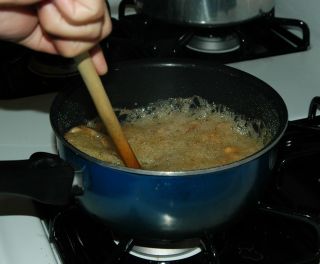 Working quickly, I used a wooden spoon to mix in the peanuts and spices. It's important to work fast (and sure) from this point on because the syrup is rapidly cooling. While you are stirring, the syrup will foam up, but the high sides of your saucepan will save you from a mess.
Working quickly, I used a wooden spoon to mix in the peanuts and spices. It's important to work fast (and sure) from this point on because the syrup is rapidly cooling. While you are stirring, the syrup will foam up, but the high sides of your saucepan will save you from a mess.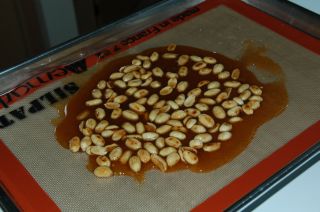 After the peanuts have been stirred in, I poured the syrup onto a silpat sheet. Syrup will flow out from the peanuts, so just use a silicone spatula or the wooden spoon to fold the excess sugar back onto the peanuts. As it thickens it won't flow anymore. At the same time, I used a silicone spatula (or back of wooden spoon) to press the peanuts down flat so you only have a single layer.
After the peanuts have been stirred in, I poured the syrup onto a silpat sheet. Syrup will flow out from the peanuts, so just use a silicone spatula or the wooden spoon to fold the excess sugar back onto the peanuts. As it thickens it won't flow anymore. At the same time, I used a silicone spatula (or back of wooden spoon) to press the peanuts down flat so you only have a single layer. 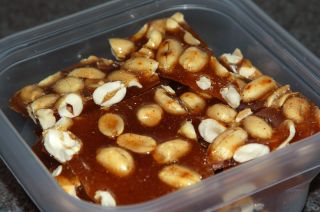 After the brittle cooled (about thirty minutes), I wrapped it in plastic wrap and broke it into 1-1/2 to 2 inch pieces with my hands. I them placed them in air tight container and brought them to work.
After the brittle cooled (about thirty minutes), I wrapped it in plastic wrap and broke it into 1-1/2 to 2 inch pieces with my hands. I them placed them in air tight container and brought them to work.I found that the brittle was indeed simple to make and tasted quite good, but wasn't as light as some other recipes. Several recipes use baking soda (or a combination of tartaric acid with baking soda) to provide some additional lift to the syrup after cooking. This produces a lighter, crispier brittle. Another common practice is to preheat the baking pan (with silicone mat) to about 200°F so the syrup continues to flow, producing a thinner, lighter brittle.
Good Eats Peanut Brittle (makes about 30 pieces)
| 3/4 cup (105 g) peanuts | combine | mix quickly | pour onto silicone sheet | flatten, cool, break | |
| 1/4 tsp. (0.6 g) cinnamon | |||||
| 1/4 tsp. (0.5 g) cayenne pepper | |||||
| 1-1/2 cup (300 g)granulated sugar | combine | boil until amber | |||
| 3/4 cup (180 mL)water |
Related Articles

First problem. The foodtv website only includes the recipes, and not nearly enough of the explanation. http://www.goodeatsfanpage.com/ publishes the full transcripts of each show, which is probably better.
Mr. Brown also has more experience than you cooking this stuff. Using a thermometer is hardly a crutch, and probably a really good idea if you're starting out (even if it's just the first time you try a recipe.)
Did he recommend wax paper or parchment paper? They aren't the same.
See here for an explanation of the two: http://www.baking911.com/pantry/list_kitchenstuff2.htm
Sounds like your sugar hadn't fully dissolved. Good chance a couple lingering crystals in there acted as a seed crystal, and the super-saturated sugar solution (woo! alliteration!) instantly crystallized on you. This is specificially the reason why Mr. Chu added corn syrup to his batch. It's a different type of sugar (fructose, I believe), and the incompatibilities in molecular shape help reduce the likelihood of all that sucrose lining up in the crystalline form it wants to.
Again, this is why you should stick with parchment paper (no wax) or a silpat mat.
I don't think it's public anymore. He used to have a contact form on his site, but that disappeared a few months ago.
-transiit
It makes the brittle lighter and imparts an earthy/nutty flavour that makes it much more tastier! Though I think setting points for raw sugar will be different than with refined sugar.
Microwave Peanut Brittle
1 cup granulated sugar
6 Tbs light corn syrup
1/8 tsp salt
1 cup raw, shelled peanuts
1 Tbs butter
1 tsp vanilla extract
2 tsp baking soda
Spray cooking oil on a 9 x 12-inch cookie sheet. Set aside until needed.
Place sugar, corn syrup, salt and peanuts in a 4-cup pyrex measuring cup. Mix well with wooden spoon.
Microwave 4-minutes at 60% power.
Stir well.
Microwave 4-more minutes at 60% power.
Stir in butter and vanilla.
Microwave 1-minute at 60% power.
Add baking soda. Stir until mixture foams.
Pour onto cookie sheet and spread evenly over sheet.
When cool, break into pieces.
Recipe is for 1500-watt , turntable microwave. For 750-watt microwave, use same cooking times, but 100% power.
For easy clean up, soak measuring cup and wooden spoon in warm water. Stuck on sugar disolves after a few minutes.
To the above poster who's angry with Alton: Perhaps you shouldn't be so quick to blame the recipe when things don't turn out correctly?
Good luck to all those beginners out there. You can do it!!
Seems to me to cover the pan is to add water to the mixture and therefore increase the cooking time you have to boil away the water to begin with.
If you don't have silicon tools, just spray the spoon or spatula you do have with pan spray before you spread out your brittle...you may want to have a couple ready to go because it will begin to stick to the first one.
Brittle should not go past 300, and in most times it is best taken off the fire at 295!
8|
www.brittlekitchen.com
"Raw, blanched, or roasted all all good in brittle."
On a candy-related note, while I've been tempted by AB's recipe, I will probably try Bittman's instead. Since it doesn't take a lot of time and effort I'll be less disappointed if [when?] it fails / I mess up.
"Raw, blanched, or roasted all all good in brittle."
Thanks for the catch - I just fixed it.
Here it is:
Set aside in a small bowl:
1.5 tsp baking soda
1 tsp water
1 tsp. vanilla
Set aside in another bowl:
1 lb. peanuts (I use roasted, salted, blanched)
3 tbsp. butter
Heat in a large, tall saucepan:
1 c. water
1 c. light corn syrup
1.5 c. sugar
Cook sugar, water, & corn syrup until temp reaches 140 F. on candy thermometer. The rapid bowl will have slowed a bit at this point. Hint of caramel color beginning.
Add peanuts and butter, and stir vigorously & continuously so it does not burn. Heat until temp reaches 300 F. I wear oven mitts to prevent bubbling sugar burns. Candy mixture will be foamy. When approaching temperature, color will be a medium light caramel. The mixture will look sticky, slightly stringy, and start to pull away from sides of the pot near the top of the mixture.
Take off heat, add soda/water/vanilla. Stir very vigorously, & be careful of it foaming. Spread in large buttered metal baking pan (no parchment/wax/silpat needed). Spread as thin as possible, about 1/4 inch.
Let cool until center of pan is no longer warm. To get out of pan, slightly flex metal pan, and candy will pop free.
Delicious.